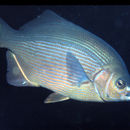Pectoral fin swimming
provided by EOL authors
Labriform swimmers, including striped surfperch, are those use their pectoral fins for locomotion. However, as a labriform fish swims faster, both the frequency and amplitude of the fin beat will reach a maximum. This implies that the pectoral fin muscles have reached their physiological limits. As a result, the tail (caudal fin) starts to supplement the fins to allow the fish to keep swimming. The speed at which this happens is called the pectoral-caudal gait transition speed, or Up-c. Drucker and Jensen (1996) have shown that for striped surfperch this speed varies based on the size of the fish.
Diagnostic Description
provided by Fishbase
Copper ground color with dark brown overlay on back; a series of about 15 blue horizontal stripes below lateral line; head with several series of blue spots and stripes; fins coppery; dark areas on anterior part of rayed dorsal, base of caudal fin, anterior part of anal, and distal halves of pelvic fins (Ref. 6885).
- Recorder
- Cristina V. Garilao
Life Cycle
provided by Fishbase
Viviparous, female carries the developing young (Ref. 205).
- Recorder
- Cristina V. Garilao
Morphology
provided by Fishbase
Dorsal spines (total): 10 - 11; Dorsal soft rays (total): 23 - 25; Analspines: 3; Analsoft rays: 29 - 33
- Recorder
- Cristina V. Garilao
Trophic Strategy
provided by Fishbase
Forages only during the day (Ref. 33994).
Biology
provided by Fishbase
Adults occur in rocky coasts and kelp beds, occasionally in sandy surf near rocks (Ref. 2850). Feed on small crustaceans, worms, and mussels; occasionally on herring eggs (Ref. 4925). Viviparous, female carries the developing young (Ref. 205).
Importance
provided by Fishbase
fisheries: commercial; gamefish: yes; aquarium: public aquariums
Embiotoca lateralis
provided by wikipedia EN
Embiotoca lateralis, commonly known as the striped surfperch or striped seaperch, is a species of surfperch native to the north-eastern Pacific Ocean.
Description
The striped surfperch is characterized by orange and blue stripes running lengthwise down the body and blue spots on the head and operculum. Individuals reach maximum lengths of 15 in (38 cm).[3]
References

- license
- cc-by-sa-3.0
- copyright
- Wikipedia authors and editors
Embiotoca lateralis: Brief Summary
provided by wikipedia EN
Embiotoca lateralis, commonly known as the striped surfperch or striped seaperch, is a species of surfperch native to the north-eastern Pacific Ocean.
- license
- cc-by-sa-3.0
- copyright
- Wikipedia authors and editors

